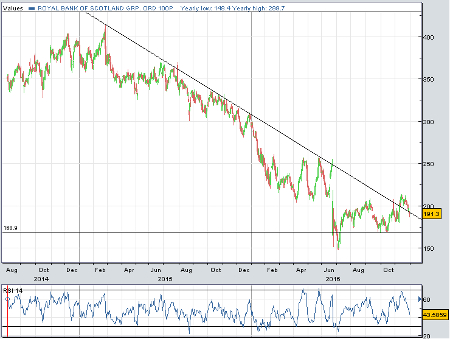RBS biggest failure in bank stress tests
30th November 2016 12:56
Eight years after the financial crisis and is still vulnerable. The bank has just been named the biggest failure of the annual Bank of England (BoE) stress test and has been forced to improve its capital position by £2 billion.
Measuring how the banks could handle a severe downturn, including a house price crash in the UK and global recession, the Bank of England tested the groups' capital strength through their low point core equity tier one (CET1) ratio and tier one leverage ratios - industry targets are set at 7.1% and 3% respectively.
Still 73% owned by the government after its 2008 bailout, RBS failed both targets, with a low point CET1 ratio of 5.5%, below its own 6.6% guidance, and leverage ratio of 2.7%. The overall CET1 ratio fell from 15.5% at the end of 2015 to 15% in the third quarter.
In a bid to improve its capital strength this year, the bank has run down its risk-weighted assets (RWAs) by a further £10.4 billion to £38.6 billion in the first nine months of 2016, and has issued an extra £2 billion of AT1 securities - hybrids that absorb losses when the bank's capital falls below a certain level.
RBS has also continued to move away from higher-risk credit portfolios, and has settled a number of litigation cases and regulatory investigations.

These actions reduced the capital gap from £3-4 billion to £1-1.8 billion, but this isn't enough. RBS was required to revise its capital raising plan, which was approved by the BoE's Prudential Regulation Authority overnight.
Most of this strategy includes already planned cost-cutting, asset disposals and capital management, but more restructuring might be needed further down the line.
"With uncertainty around timing and cost of Williams & Glyn and Department of Justice residential-mortgage-backed securities [misselling litigation], we think RBS remains under pressure to deliver on core profits, principally by achieving further significant cost cuts," says UBS analyst Jason Napier.
In the five-year stress test scenario, the Bank of England imagined that house prices fell by 31%, UK GDP crashed by 4.3% and unemployment surged to 9.5%.
, , Nationwide and passed, but and also came up short. They were saved from submitting a new plan as they are seen to have a sufficient strategy in place to raise capital.
"Lloyds Banking, our top pick in the UK, reported a 330 basis point (bps) and 130bps excess capital above CET1 and tier 1 leverage hurdles, and looks able in our view to deliver a dividend yield over 5% this year and 7% next," added Napier.
RBS's share price initially fell 5% to 187p Wednesday morning, although selling eased back to 191p by lunchtime, representing a 3% decline on Tuesday's close.
This article is for information and discussion purposes only and does not form a recommendation to invest or otherwise. The value of an investment may fall. The investments referred to in this article may not be suitable for all investors, and if in doubt, an investor should seek advice from a qualified investment adviser.
Editor's Picks